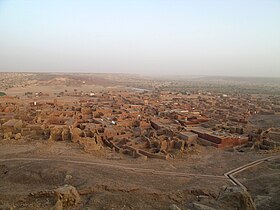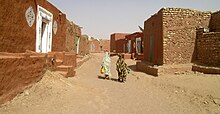Oualata
| Oualata ولاتة |
||
|---|---|---|

|
||
| State : |
|
|
| Region : | Hodh Ech Chargui | |
| Department: | Oualata | |
| Coordinates : | 17 ° 18 ′ N , 7 ° 1 ′ W | |
| Residents : | 13,787 (2010) | |
| Time zone : | GMT ( UTC ± 0 ) | |
|
|
||
Oualata (French spelling), also Walata , Arabic ولاتة, DMG Walāta , in the Middle Ages Gualata, Iwalatan, Oualet, Bīru ; is an oasis city in the administrative region of Hodh Ech Chargui in the southeast of Mauritania . It was one of the most important trade centers for caravans (gold and salt trade ), but also the meeting point for pilgrims to Mecca .
In 1332 the world traveler Ibn Battūta came to Oualata for a fifty-day visit (he himself wrote: Iwalaten ). He stated that this was the first place of the "blacks" on his journey south from Sidschilmasa in the High Atlas and belonged to the Mali Empire . According to Ibn Battuta, the Iwalaten caravan endpoint, which has not yet been definitively proven to be the same city, was the end of the caravan and replaced Aoudaghost . Clothes, salt, gold and slaves were traded. In the 15th century, the importance of the place gradually declined as the caravan trade shifted to a route further east that led through Timbuktu . The place can only be reached via a slope leading north from Néma .
Oualata is one of a total of four cities (besides Chinguetti , Ouadane , Tichitt ) in Mauritania that has been declared a World Heritage Site by UNESCO because of its closely spaced, clay-plastered stone houses . Oualata was built on a high terrace as a ksar and has a special art tradition that is still taught and practiced by the families living there to this day. Some houses are painted with symmetrical ornaments that have magical meanings.
In the 1980s only a few families lived on the outskirts of the ruined city. The census in 2000 showed 11,779 inhabitants, for 2010 13,787 inhabitants were calculated.
The city's economic base was based more on trade than agriculture. Oualata's fame is strongly linked to its madrasa , which was the leader in all of West Africa for several centuries. This Islamic religious school is still partially intact and receives around 20 new students from various Islamic countries every year.
literature
- Rainer Oßwald : The trading cities of the Western Sahara. The development of the Arab-Moorish culture of Šinqīt, Wādān, Tīšīt and Walāta. Marburg studies on Africa and Asia. Vol. 39. Dietrich Reimer, Berlin 1986
- Rudolf Fischer: Gold, Salt and Slaves. The history of the great Sudan empires of Gana, Mali and Son Ghau. Stuttgart, Edition Erdmann, 1986. ISBN 3522650107
Web links
- Entry on the UNESCO World Heritage Center website ( English and French ).
- Walata project.
Individual evidence
- ↑ Rudolf Fischer, Gold, Salz und Sklaven, p. 116 ff. (See lit.)
- ↑ Oßwald, pp. 195–197
- ↑ UNESCO World Heritage Center: Ancient Ksour of Ouadane, Chinguetti, Tichitt and Oualata. Accessed August 21, 2017 .
- ↑ Statistiques Demographiques: Résultats du RGPH 2000 des Wilayas. ( Memento of the original from February 3, 2010 in the Internet Archive ) Info: The archive link was inserted automatically and has not yet been checked. Please check the original and archive link according to the instructions and then remove this notice.
- ↑ Oualâta. World Gazetteer


